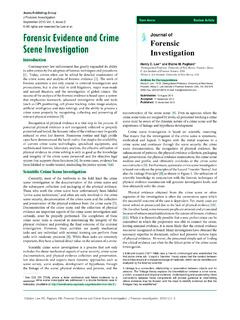Transcription of Crime Scene Investigation: A Reference for Law Enforcement ...
1 Special JUNE 04 Department of Justice Office of Justice Programs National Institute of Justice REPORT Crime Scene Investigation: A Reference for Law Enforcement Training Department of Justice Office of Justice Programs 810 Seventh Street Washington, DC 20531 John Ashcroft Attorney General Deborah J. Daniels Assistant Attorney General Sarah V. Hart Director, National Institute of Justice This and other publications and products of the National Institute of Justice can be found at: National Institute of Justice Office of Justice Programs Partnerships for Safer Communities Crime Scene Investigation: A Reference for Law Enforcement Training June 2004 NCJ 200160 Sarah V. Hart Director National Institute of Justice This document is not intended to create, does not create, and may not be relied upon to create any rights, substantive or procedural, enforceable at law by any party in any matter, civil or criminal.
2 Opinions or points of view expressed in this document represent a consensus of the authors and do not reflect the official position or policies of the Department of Justice. The National Institute of Justice is a component of the Office of Justice Programs, which also includes the Bureau of Justice Assistance, the Bureau of Justice Statistics, the Office of Juvenile Justice and Delinquency Prevention, and the Office for Victims of Crime . Contents Introduction ..1Te chnical Working Group on Crime Scene Scene Investigation: A Reference for Law Enforcement Training ..5 Section A: Arriving at the Scene : Initial Response/Prioritization of Efforts ..71. Initial Response/Receipt of Safety Emergency Care ..124. Secure and Control Persons at the Establish and Preserve Scene Boundaries.
3 156. Transfer Control of the Scene to the Investigator(s) in Charge ..177. Document Actions and Observations at the Scene ..18 Section B: Preliminary Documentation and Evaluation of the Scene ..211. Conduct Scene Conduct Scene Walk-Through and Initial Documentation ..26 Section C: Processing the Determine Team Composition ..292. Ensure Contamination Document the Prioritize Collection of Collect, Preserve, Inventory, Package, Transport, and Submit D: Completing and Recording the Crime Scene Investigation ..451. Establish Crime Scene Debriefing Team ..472. Perform Final Survey of the Crime Scene ..493. Documentation of the Crime E: Crime Scene Equipment ..531. Initial Responding Officer(s) ..552. Crime Scene Investigator/Evidence Technician ..553. Evidence Collection Kits (Examples).
4 56 Glossary ..59 Crime Scene Investigation: A Reference for Law Enforcement Training iii Introduction Note: Words and phrases that are defined in the glossary appear in bold italics on their first appearance in the body of the report. Thorough Crime Scene analysis is vitally important to effective law Enforcement . In particular, rapid techno logical advances have greatly expanded the amount of information that can be obtained from the analysis of physical evidence from a Crime Scene . In order to take advantage of these new opportunities, the investigator should use sound Scene processing practices to recover useful evidence. Critical to the administration of a Crime is the objective recognition, documentation, collection, preservation, and transmittal of physical evidence for analysis.
5 This Reference material is designed to assist trainers and administrators in developing training programs for Crime Scene investigators. It is intended to accompany Crime Scene Investigation: A Guide for Law Enforcement , pub lished by the National Institute of Justice (NIJ) in January 2000. Both publications were developed by NIJ s Technical Working Group on Crime Scene Investigation (TWGCSI). The earlier guide and these training materi als are divided into four primary sections that mirror the tasks of the investigator: Arriving at the Scene : Initial Response/Prioritization of Efforts; Preliminary Documentation and Evaluation of the Scene ; Processing the Scene ; and Completing and Recording the Crime Scene Investigation. Each part of this document includes pro posed performance objectives for the student to ensure attainment of the material.
6 NIJ recommends that student performance be measured using written and practical examinations, including the processing of a mock Crime Scene . This document can provide the basis for a new training program or as a supplement to an existing program. Any training program, however, must be adapted to the policies and experience of the administering law Enforcement agency. The Crime guide and these curriculum materials provide instructors with a framework grounded in research and based on the expertise of the TWGCSI members. The recommendations do not represent the only correct course of action and may not be feasible in all circumstances. In no case should the guide or this refer ence document be considered a legal mandate or policy directive. We expect that each jurisdiction will be able to use these recommendations to develop policies and procedures that are best suited to its unique environment.
7 We gratefully acknowledge the contributions of the TWGCSI members. They gave their time and valuable expertise for this project. NIJ relies on the contributions of experienced practitioners and researchers to advance scientific research, development, and evaluation to enhance the administration of justice and public safety. Crime Scene Investigation: A Reference for Law Enforcement Training 1 Technical Working Group on Crime Scene Investigation The Technical Working Group on Crime Scene Investigation (TWGCSI) was a multidisciplinary group of content-area experts from across the United States, from both urban and rural jurisdictions, each represent ing his or her respective agency or practice and a unique area of expertise. Each of these individuals is experi enced in the area of Crime Scene investigation and evidence collection in the criminal justice system from the standpoints of law Enforcement , prosecution, defense, or forensic science.
8 A planning group, the National Crime Scene Planning Panel (NCSPP), composed of distinguished law enforce ment, legal, and science professionals, was formed to steer the larger group. National Crime Scene Planning Panel Dr. Jose R. Almirall Associate Director and Assistant Professor International Forensic Research Institute Department of Chemistry Florida International University Miami, Florida Susan Ballou Forensic Scientist Montgomery County Police Department Crime Laboratory Rockville, Maryland Paul Carroll Sergeant (Ret.) Chicago Police Department Big Pine Key, Florida Elizabeth Farris Chief Trial Counsel Hampden County District Attorney s Office Springfield, Massachusetts Jo Ann Given ASCLD/LAB Naval Criminal Investigative Service Norfolk, Virginia Marjorie Harris Forensic Scientist, Senior Department of Criminal Justice Division of Forensic Science Richmond, Virginia Larry McCann Senior Special Agent (Ret.)
9 Virginia State Police Richmond, Virginia Additional Technical Working Group Members Hal R. Arenstein Attorney at Law Law Offices of Hal Arenstein Cincinnati, Ohio Dexter J. Bartlett Inspector Illinois State Police Crime Scene Services Command Joliet, Illinois Eric Buel Director Department of Public Safety Crime Laboratory Waterbury, Vermont Jeff Cover Supervisor, Crime Scene Unit Anne Arundel County Police Department Millersville, Maryland Elizabeth Devine Supervising Criminalist Scientific Services Bureau Los Angeles County Sheriff s Department Los Angeles, California Henry Escobar Detective San Antonio Police Department San Antonio, Texas Dr. Joseph L. Peterson Department of Criminal Justice University of Illinois Chicago, Illinois Elliot B. Spector Director Center for Police and Security Training Suffield, Connecticut Ann Talbot ASCLD/LAB Albuquerque Police Department Albuquerque, New Mexico James T.
10 Tom Thurman Associate Professor College of Law Enforcement Eastern Kentucky University Richmond, Kentucky Jerry N. Estes District Attorney General 10th Judicial District Athens, Tennessee James Estrada Detective Investigator Homicide Unit San Antonio Police Department San Antonio, Texas Drew Findling Attorney Atlanta, Georgia Crime Scene Investigation: A Reference for Law Enforcement Training 3 Nan Horvat/John Sarcone Assistant Polk County Attorney/Polk County Attorney Des Moines, Iowa N. Michael HurleyRegional Director Oregon State Police Forensic Services Division Springfield, Oregon Gary L. Kaldun Forensic Scientist, Crime Scene Coordinator Bureau of Criminal Apprehension St. Paul, Minnesota Joe Marchan Supervising Criminalist Texas Department of Public Safety Crime Laboratory McAllen, Texas Joseph John Moseley, II Detective Central Homicide Evaluation Support Squad Chicago Police Department Chicago, Illinois Robert Mullins Detective Investigative Services New Haven Police Department New Haven, Connecticut Steve Nash Detective Marin County Sheriff s Department San Rafael, California Kathryn Normington-Hollenbach Senior Forensic Scientist Wyoming State Crime Laboratory Cheyenne, Wyoming Galen Paine Assistant Public Defender Public Defender s Office Sitka, Alaska Michael J.



















